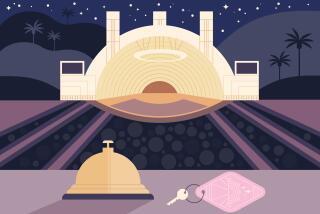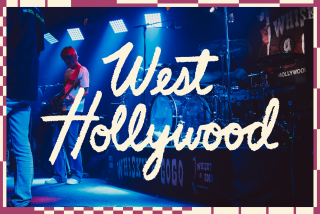Mysore Is ‘Sandalwood City’ of India
- Share via
MYSORE, India — The most spectacular of the many palaces in this southern Indian city is the former Maharajah of Mysore’s home, built in 1911 to replace an all-wood building that had burned.
Some say it was inspired by Buckingham Palace, but the intricacies of its Hindu-Muslim detail far surpass the relative simplicity of Queen Elizabeth’s London home.
Mysore is a clean and orderly city of broad boulevards lined with shade trees, well-kept buildings and gardens and parks offering the aroma of jasmine and roses. The pace is leisurely, particularly when compared to the usual bustle associated with large Indian cities.
The city is known for its handicrafts, including magnificent wood carvings inlayed with sandalwood, teak and rosewood. Every well-dressed Indian woman dreams of wearing a Mysore silk sari.
A thriving cottage industry of sandalwood incense sticks, used throughout the country, gives Mysore its nickname of “Sandalwood City.”
Getting here: Fly British Airways, Pan Am, Lufthansa or Air France, with changes, to Bombay, then take Indian Airways to Bangalore. From Bangalore it’s an 85-mile trip by car, train or bus to Mysore, which has no major airport.
How long/how much? Although Mysore is often visited on a daytrip by car or tour bus from Bangalore, give it two days. Lodging and dining is inexpensive.
A few fast facts: India’s rupee recently sold for 16.5 to the dollar, about six cents each. A rickshaw ride around town costs about 33 cents. April and May are the hottest months; rains fall June through October. September-October are beautiful months, and October is the time for Mysore’s most colorful event, the 10-day Dasara Festival.
Getting settled in: Lalitha Mahal Palace Hotel (T. Narsipur Road, five miles from town; $38 U.S. double, $90 double suite) was built as a guest house by a former Maharajah of Mysore. At first glance it resembles the U.S. Capitol, with the White House superimposed on its facade. It has 55 rooms and eight suites, all decorated with fine carpets and brocade-covered furniture. Most rooms have balconies overlooking the pool and tennis courts.
The Viceroy Suite at $225 features marble floors, antique furnishings, silk draperies and bed coverings, canopied beds, teak closets and enormous baths. All public areas are on the same grand scale, including the marble mosaic hallways.
Southern Star Quality Inn (Vinoba Road; $30 double, $48 deluxe) is a new and modern hotel with most Western amenities. A cool, white-marble lobby leads into several dining rooms that serve Indian, Western and continental food.
Outside are the pool, a tandoori barbecue and a small bar. Rooms are spacious. Live music and other entertainment are offered in the dining rooms.
Hotel Metropole (Jhansi Lakshmibai Road; $22 double) is for those watching their rupees, but it still has a modicum of charm. Bedrooms are huge, with ceiling fans and mosquito netting on the beds. It’s $14 for doubles without air conditioning.
Regional food and drink: Mysore is noted for its thalis , a vegetarian meal usually served on a tray of small dishes that could contain soup, cabbage, lentils, mixed vegetables, yogurt, rice and dessert.
Specialties include rasam , a spiced lentil soup, and pachadi , a spiced yogurt with coconut and chiles. Chinese food and clay-oven tandoori meats introduced to India by the Moguls also are available. Mysore has a reputation for India’s best masala dosa , a mix of curried vegetables wrapped in a lentil-flour pancake.
Good dining: Soft flute and drum music accompanies meals in the regal Lalitha Mahal Palace dining room. Guests eating Indian, continental or Mysore specialties will find them a delight, particularly in the evening. They do great thalis for under $3, a fine chicken tikka plus fresh fish and steaks. Non-guests also will appreciate the dining room.
The Gun House (opposite entry to Maharajah’s Palace) was where the maharajah formerly kept his guns, artillery and powder. It’s a colorful restaurant serving Indian, Chinese and continental food. You can get a lamb shashlik for $1.25, curried lamb for $1 and various tandooris for $1.10. Soups and vegetables are about 50 cents each. In the evening there is live entertainment.
Hotel Metropole’s dining room is basic, and the tables are covered with neat white covers. It serves lots of Indian and Chinese dishes for less than $2, plus samosas (curried vegetables in pastry) for half that. Here, as in every other Indian hotel and restaurant, you should avoid local beverages and choose beer, soft drinks or bottled water.
On your own: The Maharajah’s Palace, one of India’s largest, overwhelms with size. Because the late maharajah’s son is still in residence, visitors walk along a prescribed route through huge rooms, hallways, courts and a throne room. The decor is gilt, mirrors, silver doorways, paintings, statuary, mosaics and intricately carved teak and mahogany walls and ceilings.
On Sunday and festival evenings, the palace exterior shines with thousands of tiny lights in every column, archway and dome. The effect is spellbinding.
Find time for a trip to Brindavan Gardens, with its long and beautiful expanse of terraces, ponds and shimmering fountains.
Combine a luncheon trip to Lalitha Mahal Palace Hotel with a drive into the Chamundi Hills. High in the hills you’ll find the great Nandi bull (the Hindu god Siva’s holy mount) carved in the 17th Century from a single piece of black granite.
The bull is always garlanded with flowers and ribbons offered by pilgrims. At the crest of the hill, the 130-foot tower of Sri Chamundeswari temple commands a stunning view of the valley and town.
Just outside town off Bangalore road you’ll find the fortress of Srirangapatna, along with the Darya Daulat summer palace and the tomb of Tipu Sultan, a legendary leader killed by the British in 1799. The Hindu-Mughlai palace is constructed 80% of teak, with beautiful paintings, murals and carved ceilings.
Try to stop in at a silk or incense-stick factory. The latter, usually family affairs, are all over town. It’s claimed that a deft worker can turn out more than 10,000 sticks a day.
For more information: Call the Government of India Tourist Office at (213) 380-8855, or write to 3550 Wilshire Blvd., Suite 204, Los Angeles 90010 for a brochure on the India Experience.
More to Read
Sign up for The Wild
We’ll help you find the best places to hike, bike and run, as well as the perfect silent spots for meditation and yoga.
You may occasionally receive promotional content from the Los Angeles Times.






